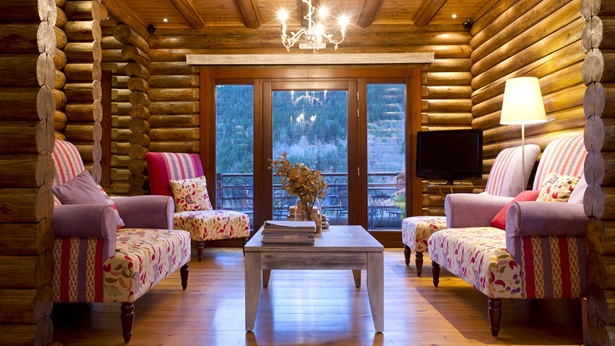The Right Recipe for a Dream Kitchen
The right recipe for an affordable kitchen involves healthy portions of common sense and a dash of practicality
Ah, the kitchen. To some, it’s just a utilitarian place to start and end the day in a hurry. But to you, it’s a place to linger and come alive with the laughter of friends and family, aromas that melt your heart and concoctions that make each day a sweet surprise.
But then reality rears its ugly head — in the form of your budget. While we would love to to indulge your passions with a restaurant-sized kitchen, you sadly discover that your budget is on a diet. Don’t worry. You can still cook up a yummy kitchen without leaving a bad taste in your mouth. All it takes is some ingenuity, say kitchen designers.
Sizing Up Kitchen Space in Log Homes
Start by visiting the members of the Log and Timber Homes Council because these companies can help you design your kitchen. But even more importantly, all members of the Log and Timber Homes Council adhere to a code of ethics, grade their logs to ensure quality, provide construction manuals, sponsor scientific studies to improve log building technology and provide free information to consumers.
These companies have already drawn floor plans and designs that will help you imagine where your kitchen will be on your building site. Don’t make the mistake of putting the garage on one side of the home and the kitchen on the other. We don’t want to spend our golden years lugging groceries from one end of the house to the other, now do we? Kitchen designers recommend positioning the kitchen near the garage, to have the kitchen serve as an easy “landing zone” for all your foodstuffs.
Will it be open to the great room? Because they are often the heart of the home, kitchens today are open to the main living areas to serve as a gathering place and refreshment center. What size should it be? The larger it is, the more you’ll spend. The size of the space will drive your costs.
Sizing Up Costs
In fact, kitchens are the most expensive room in a home, costing anywhere from 5 to 15% of your budget. If money is tight, try an 8-by-10-foot space, or 10-by-10. Some designers recommend 9-by-12 size to be optimal. This size is large enough to accommodate an island, lots of storage and maneuverability for those with a disability.
As you begin to select the individual components that create a kitchen, try to balance three objectives — functionality, aesthetic appeal and the illusion of spaciousness, designers say.
When space is tight, sink placement is crucial to your kitchen’s functionality. What may look great in a floor plan, may not work in the real world. For example, corner sinks are often popular because you can gain outside views in two directions. This may seem a little more “inspired” until the new homeowner realizes that he or she cannot open the dishwasher door while standing at the sink.
Island sinks may seem like a good solution at first glance. But the trend towards uniform-height islands (no raised snack bar to serve as a backsplash) means the flooring around that island sink is going to get wet — a lot. This can be a recipe for disaster, especially if you have tile or wood floors, which will be slippery. This is why many designers have returned to the sink facing out the outside on one wall, with a single window over it to save wall space for cabinets.
Other design tips to save money and space:
- Use a “work triangle” to save steps between the oven, sink and refrigerator.
- “U” shape kitchen is one of the most efficient.
- Both “U” and “L” shapes work well with an island.
- Parallel- or single-wall layouts are least efficient.
- Minimum 8 to 10 feet of overall counter space
- Counter space (18-inch minimum) beside latch side of refrigerator.
- Counter space (24-inch minimum) on either side of sink.
- Counter space (18-inch minimum) on either side of range, to accommodate left- or right-handed chefs.
- Increase the illusion of spaciousness with glass door kitchen cabinets.
Savvy Storage
Although the work triangle is important to any kitchen, it shouldn’t be your sole focus. Equally important is storage. To save money, many of us today are buying in bulk at the big box stores. This means we need the space to store it.
A general rule in kitchen design is to have at least 18 square feet of general storage with six additional square feet per person for the household. A smart storage solution is to devote 4-by-4 or 6-by-6 space for a walk-in pantry. Save money by not having the pantry outfitted with custom cabinetry. Just have your builder frame it instead.
Another item that can be built by your builder (or a DIY’er) is the kitchen island. Islands can serve as the place to grab a quick breakfast, an intimate dinner for two, serve as a bar for entertaining, and one can store a lot of stuff in it too.
Other storage strategies:
- Finish the pantry with drywall or a log siding finish and equip this space with prefab circular rotating shelving, which will offer a vast amount of storage in a space not much larger than a small closet
- Add power and a countertop to your pantry for additional workspace.
- Hanging pots above the range will save cabinet space and add visual appeal.
- Under cabinet microwave will increase counter space.
- Use appliance garages for appliances you don’t use everyday.
- Mount cubbyholes underneath an upper cabinet to organize mail, bills and takeout menus.
- Install a communication workstation and chair to answer emails and research recipes on the Internet. This is increasingly importantly, since kitchens now commonly do triple duty — food prep, entertaining space and communication center. It’s helpful to be able to close off this space when company arrives.
- Choose lazy Susan shelving in any corner units to make the most use of your built-in cabinetry.
- Another option is to turn a hallway adjacent to the kitchen into long pantry by widening it by a foot or more. Then add floor-to-ceiling glass-front cabinets and stock with glassware and dishes. This will add texture and color to the passageway.
- To increase cabinetry storage, limit yourself to one window in the kitchen — usually above the sink.
- If you need a TV in the kitchen, mount it inside a cabinet.
Cabinets and Countertops
Cabinets and countertops are the furniture of this space. Just as with any other kind of furniture, there is a relationship between cost and quality. Typically the more hardwood in your cabinets, the more expensive, better constructed and more durable they will be. Engineered wood covered with a vinyl veneer to simulate hardwood will be the least expensive. Full hardwood will be at the other end of the cost, elegance and durability spectrum.
Typically the big-ticket item for any kitchen, you can cut costs dramatically in cabinetry by buying less expensive pine or engineered wood cabinets and then painting or distressing them your self.
If you agonize over decisions, get ready to go into option overload when it comes to countertops. Today they come in wood, tile, stone, composite, solid-surface, laminate, concrete and steel, with many variations in color and texture in each category.
The least expensive countertop material is plastic laminate ($8-$20), but that won’t make the choices any easier. Manufacturers offer more than a hundred colors and scores of different patterns. Solid surface counter tops are more expensive, but they’ll last a lifetime. If you’re on a budget and can’t afford the one brand that makes your mouth water, don’t panic. You have the option to change them in the future. Some home owners are discovering they’d rather change out their countertops every 10 or 15 years to change the look of the room, designers say.
Other Money Saving Tips
With some creativity, you can cut costs in every category.
- Lighting: Logs absorb light, so you’ll need twice the amount of lighting as a conventional home. Invest in wiring your home for multiple task lighting locations (above the sink, stove, frig and island at minimum), then purchase inexpensive electrical fixtures. You can always add the antler chandelier later. A skylight can make even the smallest kitchen seem spacious, but they can be pricey. Instead install solar tubes (around $300–$500 each) your self in a weekend.
- Appliances: Every manufacturer from Viking and General Electric to Sears has distribution centers where they liquidate items that have been damaged in transit or returned because customers didn’t like the look or color. You may have to drive a ways to reach one of these “scratch and dent” centers, but you’ll save up to 50% off full retail. For an even better deal, find out when these centers have their own clearance sales.
- Flooring: Fashion often competes with function when it comes to choosing flooring for your new log and timber home. What’s comfortable to the touch and appealing to the eye, will have to be weighed against cost, safety, durability and resistance to stains or water damage. If you are running low on funds, consider a vinyl or laminate product that duplicates the look of the material you prefer.
As you select materials and appliances for each category, decide what you can afford now and what can be upgraded later. As you contemplate choices, keep in mind that products you choose must be durable, stain-resistant, easy to clean, attractive and affordable.
Aging Gracefully in Your Kitchen
If you anticipate this being your last home, you may want to alter your kitchen design slightly to accommodate your physical needs as you age. Installing aging-in-place features is not rocket science. With proper planning and forethought, it can be accomplished cost efficiently and effectively. However, they do require some extra thought in the design and planning phase. Here are basic concepts that require little or no additional costs.
- Add More Lighting:
- After age 60, it takes three times the amount of light you would need to accomplish the same task at age 19. This is why you should increase task lighting fixtures for cooking.
- Multiple controls reduce the need to cross the room to turn lights on or off.
- Dimmers help avoid glare and ensure proper lighting for each situation.
- Simple Adjustments:
- Opt for cabinets with pull out shelving, so you won’t have to bend as much to retrieve pots and pans.
- Raise the dishwasher by a foot or two feet, so it’s easier to load and unload.
- Install lever door handles and D-shaped cabinet handles, which are easier to use.
- Raise the location of electrical outlets on the wall.
- Lower light switches to 40 inches above the floor.
- Ensure appliance controls have large numerals so they are easy to read. So now go forth and design your little kitchen that could.
And don’t forget to only shop the companies that belong to the Log and Timber Homes Council.



